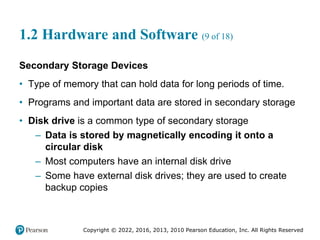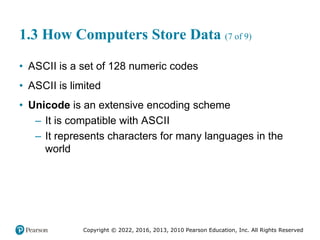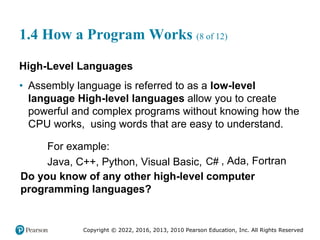ch01_Intro to Computer & Programming.pdf
- 1. Starting out with Programming Logic and Design Sixth Edition Chapter 1 Introduction to Computers and Programming Copyright © 2022, 2016, 2013, 2010 Pearson Education, Inc. All Rights Reserved
- 2. Copyright © 2022, 2016, 2013, 2010 Pearson Education, Inc. All Rights Reserved 1.1 Introduction (1 of 4) • People use computers at… – School for writing papers, research, email, online classes, etc. – Work for analyzing data, make presentations, business transactions, communicating, control machines, etc. – Home for paying bills, shopping online, communicating, playing computer games, etc. What are some of the ways you use computers?
- 3. Copyright © 2022, 2016, 2013, 2010 Pearson Education, Inc. All Rights Reserved 1.1 Introduction (2 of 4) • Devices that are computers… – SmartPhones – MP3 Players – Tablets – Car navigation system (GPS) Can you think of some other devices that are computers?
- 4. Copyright © 2022, 2016, 2013, 2010 Pearson Education, Inc. All Rights Reserved 1.1 Introduction (3 of 4) • Computers are designed to do any job that their programs tell them to do. • A program is a set of instructions that a computer follows to perform a task. For example: Microsoft Word and PowerPoint • Programs are commonly referred to as software. What software have you used?
- 5. Copyright © 2022, 2016, 2013, 2010 Pearson Education, Inc. All Rights Reserved 1.1 Introduction (4 of 4) • Programmers or Software Developers are the individuals that create computer software. • They have the training and skill to design, create, and test computer programs. What are some of the fields in which computer programs are used?
- 6. Copyright © 2022, 2016, 2013, 2010 Pearson Education, Inc. All Rights Reserved 1.2 Hardware and Software (1 of 18) Concept: The physical devices that a computer is made of are referred to as the computer’s hardware. The programs that run on a computer are referred to as software.
- 7. Copyright © 2022, 2016, 2013, 2010 Pearson Education, Inc. All Rights Reserved 1.2 Hardware and Software (2 of 18) Hardware • The physical devices that a computer is made of are referred to as the computer’s hardware. • A computer is a system of devices that work together.
- 8. Copyright © 2022, 2016, 2013, 2010 Pearson Education, Inc. All Rights Reserved 1.2 Hardware and Software (3 of 18) Hardware A Computer System consists of: • Central Processing Unit (CPU) • Main memory • Secondary storage • Input devices • Output devices Figure 1-2 Typical components of a computer system
- 9. Copyright © 2022, 2016, 2013, 2010 Pearson Education, Inc. All Rights Reserved 1.2 Hardware and Software (4 of 18) Hardware Central Processing Unit (CPU) • The CPU is the part of a computer that runs the programs. • Often referred to as the processor. • Without a CPU, a computer cannot run software. Running or executing a program is the term used when the computer performs the tasks that the program tells it to do.
- 10. Copyright © 2022, 2016, 2013, 2010 Pearson Education, Inc. All Rights Reserved 1.2 Hardware and Software (5 of 18) Hardware ENIAC • World’s first programmable computer • Built in 1945 • Designed to calculate artillery ballistic tables for the U.S. Army • CPU was 8 feet tall, 100 feet long, and weighed 30 tons Figure 1-3 The ENIAC computer (courtesy of U.S. Army Historic Computer Images)
- 11. Copyright © 2022, 2016, 2013, 2010 Pearson Education, Inc. All Rights Reserved 1.2 Hardware and Software (6 of 18) Microprocessor • Much smaller • Much more powerful Figure 1-4 A lab technician holds a modern microprocessor (photo courtesy of Intel Corporation)
- 12. Copyright © 2022, 2016, 2013, 2010 Pearson Education, Inc. All Rights Reserved 1.2 Hardware and Software (7 of 18) Main Memory • Considered the computer’s work area • Computer stores the program that is running as well as the data • Commonly known as the random-access memory (RAM) • Data is quickly accessed • RAM is a volatile type of memory • Used for temporary storage • RAM is erased when computer is turned off
- 13. Copyright © 2022, 2016, 2013, 2010 Pearson Education, Inc. All Rights Reserved 1.2 Hardware and Software (8 of 18) • Read-Only Memory (ROM) – A computer can read the contents of ROM, but it cannot change its contents, or store additional data there. – ROM is nonvolatile. It does not lose its contents, even when the computer’s power is turned off. – ROM is typically used to store programs that are important for the system’s operation. For example, the computer’s startup program, which is executed each time the computer is started.
- 14. Copyright © 2022, 2016, 2013, 2010 Pearson Education, Inc. All Rights Reserved 1.2 Hardware and Software (9 of 18) Secondary Storage Devices • Type of memory that can hold data for long periods of time. • Programs and important data are stored in secondary storage • Disk drive is a common type of secondary storage – Data is stored by magnetically encoding it onto a circular disk – Most computers have an internal disk drive – Some have external disk drives; they are used to create backup copies
- 15. Copyright © 2022, 2016, 2013, 2010 Pearson Education, Inc. All Rights Reserved 1.2 Hardware and Software (10 of 18) • Solid-State drives are becoming increasingly popular – Does not contain a disk. Instead, it stores data in solid-state memory – No moving parts – Operates faster than a traditional disk drive
- 16. Copyright © 2022, 2016, 2013, 2010 Pearson Education, Inc. All Rights Reserved 1.2 Hardware and Software (11 of 18) • USB drives are small devices that plug into the computer’s universal serial bus (USB) port – It does not contain a disk – The data is stored on flash memory – Also known as memory sticks and flash drives – Inexpensive, reliable, and small
- 17. Copyright © 2022, 2016, 2013, 2010 Pearson Education, Inc. All Rights Reserved 1.2 Hardware and Software (12 of 18) • Optical devices (CD or DVD) – Data is encoded as a series of pits on the disc’s surface – Uses laser to encode the data – Holds large amounts of data – Good medium for creating backups
- 18. Copyright © 2022, 2016, 2013, 2010 Pearson Education, Inc. All Rights Reserved 1.2 Hardware and Software (13 of 18) • Cloud Storage – When you store data in the cloud, you are storing it on a remote server via the internet, or via a company’s private network. – You can access it from many different devices, and from any location where you have a network connection. – Can also be used to backup important data that is stored on a computer’s disk.
- 19. Copyright © 2022, 2016, 2013, 2010 Pearson Education, Inc. All Rights Reserved 1.2 Hardware and Software (14 of 18) Input Devices • Any data the computer collects from people and from other devices is called input. • The hardware component that collects the data is called an input device. • Common input devices are: – Keyboard – Mouse – Touch screen – Scanner – Microphone – Digital camera Can you think of any other input devices?
- 20. Copyright © 2022, 2016, 2013, 2010 Pearson Education, Inc. All Rights Reserved 1.2 Hardware and Software (15 of 18) Ouput Devices • Any data the computer produces for people or for other devices is called output. • The hardware component that formats and presents the data is called an output device. • Common output devices are: – monitor – printer Can you think of any other output devices?
- 21. Copyright © 2022, 2016, 2013, 2010 Pearson Education, Inc. All Rights Reserved 1.2 Hardware and Software (16 of 18) Software • Everything a computer does is controlled by software. • Two categories of software: – System software – Application software
- 22. Copyright © 2022, 2016, 2013, 2010 Pearson Education, Inc. All Rights Reserved 1.2 Hardware and Software (17 of 18) System Software • Programs that control and manage the basic operations of a computer are referred to as system software. • Includes the following types: – Operating System controls the internal operations of the computer’s hardware and manages all of the devices connected to the computer. – Utility Programs perform a specialized task that enhances the computer’s operation or safeguards data. – Software Developments Tools are programs that are used to create, modify, and test software.
- 23. Copyright © 2022, 2016, 2013, 2010 Pearson Education, Inc. All Rights Reserved 1.2 Hardware and Software (18 of 18) Application Software • Programs that people normally spend most of their time running on their computers performing everyday tasks are referred to as application software. • For example: – Word processing – Spreadsheet – Database – Presentation Can you think of any other application software?
- 24. Copyright © 2022, 2016, 2013, 2010 Pearson Education, Inc. All Rights Reserved 1.3 How Computers Store Data (1 of 9) Concept: All data that is stored in a computer is converted to sequences of 0s and 1s.
- 25. Copyright © 2022, 2016, 2013, 2010 Pearson Education, Inc. All Rights Reserved 1.3 How Computers Store Data (2 of 9) • A computer’s memory is divided into tiny storage locations known as bytes • One byte represents one number • A byte is divided into eight smaller storage locations known as bits (binary digits) • Bits are tiny electrical components that can hold either a positive or a negative charge. • A positive charge is similar to a switch in the on position • A negative charge is similar to a switch in the off position Figure 1-6 Think of a byte as eight switches
- 26. Copyright © 2022, 2016, 2013, 2010 Pearson Education, Inc. All Rights Reserved 1.3 How Computers Store Data (3 of 9) Storing Numbers • The positive charge or the on position is represented by the digit 1 • The negative charge or the off position is represented by the digit 0 • This corresponds to the binary numbering system where all numeric values are written as a sequence of 0s and 1s • Each digit in a binary number has a value assigned to it Figure 1-8 The values of binary digits as powers of 2
- 27. Copyright © 2022, 2016, 2013, 2010 Pearson Education, Inc. All Rights Reserved 1.3 How Computers Store Data (4 of 9) For example: Figure 1-10 Determining the value of 10011101 Figure 1-11 The bit pattern for 157
- 28. Copyright © 2022, 2016, 2013, 2010 Pearson Education, Inc. All Rights Reserved 1.3 How Computers Store Data (5 of 9) • The largest value that can be stored in a byte with eight bits is 255 • Two bytes are used for larger numbers; maximum value is 65535 Figure 1-12 Two bytes used for a large number
- 29. Copyright © 2022, 2016, 2013, 2010 Pearson Education, Inc. All Rights Reserved 1.3 How Computers Store Data (6 of 9) Storing Characters • Characters are stored in the computer’s memory as binary number • ASCII (American Standard Code for Information Interchange) is a coding scheme Figure 1-13 The letter A is stored in memory as the number 65
- 30. Copyright © 2022, 2016, 2013, 2010 Pearson Education, Inc. All Rights Reserved 1.3 How Computers Store Data (7 of 9) • ASCII is a set of 128 numeric codes • ASCII is limited • Unicode is an extensive encoding scheme – It is compatible with ASCII – It represents characters for many languages in the world
- 31. Copyright © 2022, 2016, 2013, 2010 Pearson Education, Inc. All Rights Reserved 1.3 How Computers Store Data (8 of 9) Advanced Number Storage • Binary numbering system can be used to represent only integer numbers • Negative numbers are encoded using two’s complement • Real numbers are encoded using floating-point notation
- 32. Copyright © 2022, 2016, 2013, 2010 Pearson Education, Inc. All Rights Reserved 1.3 How Computers Store Data (9 of 9) Other Types of Data • Digital data is data that is stored in binary • A digital device is any device that works with binary data • Digital images are composed of tiny dots of color known as pixels (picture elements) • Digital sound is broken into small pieces known as samples
- 33. Copyright © 2022, 2016, 2013, 2010 Pearson Education, Inc. All Rights Reserved 1.4 How a Program Works (1 of 12) Concept: A computer’s CPU can only understand instructions that are written in machine language. Because people find it very difficult to write entire programs in machine language, other programming languages have been invented.
- 34. Copyright © 2022, 2016, 2013, 2010 Pearson Education, Inc. All Rights Reserved 1.4 How a Program Works (2 of 12) • CPU is the most important component in a computer • CPU is not a brain • CPU is not smart • CPU is an electronic device that is designed to do specific things.
- 35. Copyright © 2022, 2016, 2013, 2010 Pearson Education, Inc. All Rights Reserved 1.4 How a Program Works (3 of 12) CPU is designed to perform the following operations: • Read a piece of data from main memory • Adding two numbers • Subtracting one number from another number • Multiplying two numbers • Dividing one number by another number • Moving a piece of data from one memory location to another • Determining whether one value is equal to another value
- 36. Copyright © 2022, 2016, 2013, 2010 Pearson Education, Inc. All Rights Reserved 1.4 How a Program Works (4 of 12) • CPU only understands instructions written in machine language • Machine language instructions are written in 1s and 0s • The entire set of instructions that a CPU can execute is known as the CPU’s instruction set • Each brand of microprocessors (Intel, AMD, and Motorola) has a unique instruction set
- 37. Copyright © 2022, 2016, 2013, 2010 Pearson Education, Inc. All Rights Reserved 1.4 How a Program Works (5 of 12) • Fetch-decode-execute cycle is the term used when the CPU executes the instructions in a program. • The cycle consist of three steps: – Fetch – Decode – Execute Figure 1-16 The fetch-decode- execute cycle
- 38. Copyright © 2022, 2016, 2013, 2010 Pearson Education, Inc. All Rights Reserved 1.4 How a Program Works (6 of 12) From Machine Language to Assembly Language • Computers only understand machine language • Machine language is difficult to write • Assembly language uses short words that are known as mnemonics • Assembler is used to translate an assembly language program to machine language
- 39. Copyright © 2022, 2016, 2013, 2010 Pearson Education, Inc. All Rights Reserved 1.4 How a Program Works (7 of 12) Figure 1-17 An assembler translates an assembly language program to a machine language program
- 40. Copyright © 2022, 2016, 2013, 2010 Pearson Education, Inc. All Rights Reserved 1.4 How a Program Works (8 of 12) High-Level Languages • Assembly language is referred to as a low-level language High-level languages allow you to create powerful and complex programs without knowing how the CPU works, using words that are easy to understand. For example: Java, C++, Python, Visual Basic, C# , Ada, Fortran Do you know of any other high-level computer programming languages?
- 41. Copyright © 2022, 2016, 2013, 2010 Pearson Education, Inc. All Rights Reserved 1.4 How a Program Works (9 of 12) Key Words, Operators, and Syntax: an Overview • Key words or reserved words have specific meaning and purpose in the programming language • Operators perform various operations on data • Syntax is a set of rules that must be strictly followed when writing a program • Statements are individual instructions written in a programming language
- 42. Copyright © 2022, 2016, 2013, 2010 Pearson Education, Inc. All Rights Reserved 1.4 How a Program Works (10 of 12) Compilers and Interpreters • The statements written in a high-level language are called source code or simply code • Source code is translated to machine language using a compiler or an interpreter • Syntax error is a mistake such as a: – Misspelled word – Missing punctuation character – Incorrect use of an operator
- 43. Copyright © 2022, 2016, 2013, 2010 Pearson Education, Inc. All Rights Reserved 1.4 How a Program Works (11 of 12) • Compiler is a program that translates a high-level language program into a separate machine language program Figure 1-18 Compiling a high-level program and executing it
- 44. Copyright © 2022, 2016, 2013, 2010 Pearson Education, Inc. All Rights Reserved 1.4 How a Program Works (12 of 12) • An interpreter is a program that both translates and executes the instructions in a high-level language program Figure 1-19 Executing a high-level program with an interpreter
- 45. Copyright © 2022, 2016, 2013, 2010 Pearson Education, Inc. All Rights Reserved 1.5 Types of Software Programs generally fit into one of two categories • System software – The set of programs that control or enhance the operation of a computer such as an Operating System, Utility Programs, or Software Development Tools. • Application software – Programs that make a computer useful for every day tasks such as Microsoft Word, email programs, and Web browsers.
- 46. Copyright © 2022, 2016, 2013, 2010 Pearson Education, Inc. All Rights Reserved Copyright













































